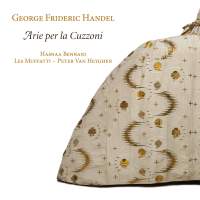Texte paru dans: / Appeared in: |
|
|
Outil de traduction ~ (Très approximatif) |
|
|
Reviewer: Bertil
van Boer Soprano Francesca Cuzzoni (1691–1772) was, according to gossip during her career, a singer whose personal life abounded with illicit affairs. This reminds one of the tabloids today, and like these, her “exploits” created great interest in her career. In 1720, after some spectacular successes in Italy and Germany, she was contracted to come to London, where she soon became the toast of the town. It took her two years to make the journey, with increasing impatience being demonstrated by her new audience. Finally, in early 1723 she was in line to premiere one of Handel’s operas, but pulled a diva on him. Handel, a heavy-set and strong man, apparently picked her up by her waistband or corset and threatened to throw her out the window if she did not obey his musical instruction. She caught the drift, and thereafter Cuzzoni became one of his favorite lead sopranos, for whom he embellished much of his music. One might think that this was a magical duo, but when Faustina Bordoni, whose husband Johann Adolf Hasse was considered Handel’s successor in Italy, appeared as a rival, the competition was on. She lost. Although she left London in disappointment with the victory of her rival in 1728, she returned only briefly to sing for Handel’s rival, the Opera of the Nobility, but she could never regain her former stature. Her final years were spent making buttons for a pittance, ending a long life in obscurity and poverty. With the plethora of complete Handel operas now being produced and recorded, it is high time that one turns the tables slightly to focus on his individual singers. These were equally as much stars, and the music written for them was usually closely tailored to their strengths. This disc provides an important cross-section that shows the breadth that Handel endowed his music with for his favorite soprano. The result, devoid of the close dramatic needs of the stage in modern performance, demonstrates the skill and dexterity of Cuzzoni in her prime. The disc consists of nine arias, some with opening recitatives, taken from what might be termed the greatest hits of Cuzzoni’s career. Of course, most of these have been recorded as part of complete Handel operas, but here the focus is on the voice itself. In order to provide some contrast and to divide the vocal numbers, Les Muffatti has included some odds and ends from the instrumental works in the operas. The disc opens with the overture to Scipione, a typically Handelian work with a slow introduction replete with dotted rhythms, but with a nicely leisurely pace that doesn’t dawdle. This in turn leads onwards to an only slightly advanced tempo where the dance origins of Handel’s themes are evident, even though it is contrapuntal. The set ends with a royal march, replete with powerful high horns. Elsewhere, the instrumental numbers follow this not-too-slow-not-too-rapid pace, allowing for his themes to unfold rather than develop. For instance, in the short sinfonia to the fourth scene from Admeto, the entire single-movement work is a bourée, with regal horns. The solos by Moroccan-French soprano Hasnaa Bennani are impressive as they enter. The mournful aria “Se pietà” from Giulio Cesare is dark and rich, and her determined expression of the text comes forth strongly. In “Scoglio d’immota fronde,” the scurrying strings and oboe octaves sounding like distant trumpets prepare for a tour de force in which she imitates the fast-paced motion with even more quick and lively ornamentation (in the da capo). The aria “Non è piu tempo” from Tamerlano has her precisely imitating in antecedent-consequent fashion the terse instrumental lines, and yet towards the cadence she rises thrillingly up into the higher registers. In “Se’il mio duol” from Rodelinda, the ghostly bassoons and flutes outline a steady gait that she eases into, echoing the pensive mood. In the final “Torni omai la pace,” she scudders about with slight ornaments at every turn, effortlessly making them seem natural. If there is any comment to make, it is that Bennani’s voice, particularly in the recitatives, sometimes is slightly off, but these are only instantaneous lapses. Her tone is dark and rich, and yet she has the higher registers and flexibility to accommodate Handel’s often variable lines. In short, she does Cuzzoni proud, and given the excellent accompaniment of Les Muffatti under the secure direction of Peter van Heyghen, this combines into a wonderful exploration of the Handelian repertory of his favorite soprano. | |
|
|
|
|
Cliquez l'un ou l'autre
bouton pour découvrir bien d'autres critiques de CD |
|




